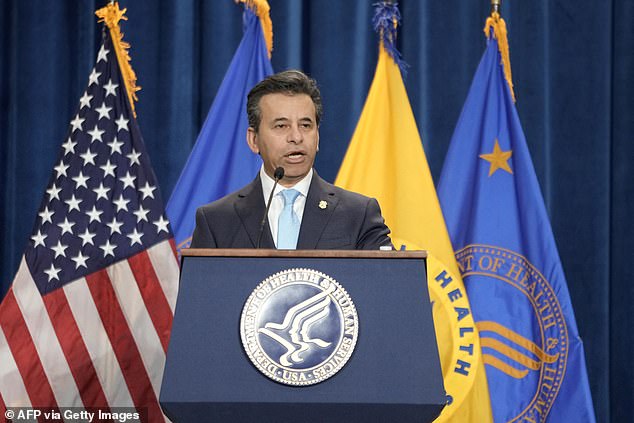FDA Commissioner Dr Marty Makary announced the agency will phase out the use of eight artificial food dyes in America’s food supply within the next two years.
The massive shakeup will free children from the ‘toxic soup’ that makes up much of America’s food supply, Dr Makary said.
Dr Makary, a trained surgeon, began his remarks by calling attention to an oft-cited review in The Lancet, which reported ties between artificial food dyes and hyperactivity in children.
‘So why are we taking a gamble,’ Makary said.
The Trump administartion will set a plan for food companies to follow in order to adequately phase out the use of Red 40, Yellow 5, Yellow 6, Blue 1, Blue 2, and Green 3 by the end of 2026 and start using natural alternatives, which the FDA will approve or deny first.
‘To the companies currently using these dyes,’ Makary said, grabbing a small bottle of juice off the podium, ‘try watermelon juice or beet juice.’
The latest proposal also revokes approval for two dyes, citrus red 2 and orange B, which are not as common as the other dyes included in Tuesday’s announcement.
RFK Jr suggested more additives could be next, telling the crowd: ‘We’re going to get rid of the dyes and we’re going to to get rid of every ingredient and additive in food that we can legally address.
‘And for those ingredients we can’t ban legally, we’re going to start informing Americans about what they’re eating.’

FDA Commissioner Dr Marty Makary announced the agency will phase out the use of eight artificial food dyes in America’s food supply within the next two years.
The plan also initiates a collaboration with the NIH to research how food dyes impact children’s health and development.
The new timeline follows a recent meeting where he urged food industry executives to eliminate artificial dyes from products before his term ends in 2028.
Dr Makary said: ‘This is not a silver bullet that will immediately make America’s children more healthy,’ but added that the Administration is ‘not interested in going down the same old path while watching America’s children get sicker.’
The FDA currently allows 36 food color additives, including eight synthetic dyes.
The FDA will push food manufacturers to eliminate Red 3 faster than the original 2027 deadline set by the Biden administration. (Pharmaceutical companies were given until 2028 to remove it from medications.)
The dyes Kennedy wants to remove are used widely in US foods. In Canada and in Europe — where artificial colors are required to carry warning labels — manufacturers use natural substitutes.
Some states, such as California and West Virginia, recently enacted laws that ban artificial colors and other additives from school meals, and in some cases, the broader food supply.
RFK said: ‘Four years from now we’re going to have most of these products off the market or you will know about them when you go to the grocery store.’

RFK Jr suggested more additives could be next, telling the crowd: ‘We’re going to get rid of the dyes and we’re going to to get rid of every ingredient and additive in food that we can legally address’
The FDA will fast-track approvals for ‘natural’ food dyes like calcium phosphate, galdieria extract blue, gardenia blue.
RFK said one of his top priorities would be to increase transparency in the food industry, which has not agreed to or weighed in on these terms yet.
He has long railed against Big Food and attributed the country’s ‘chronic disease epidemic’ to additives and ultra processed foods.
He said: ‘All of these industries have cast a dark shadow historically over this agency, and there are so many conflicts that we are now systematically eliminating.
‘That has allowed them to suppress the science. There’s shockingly few studies, even on food dyes.’
RFK pledged that labels on foods that contain artificial colors will be labeled clearly
Red 40 is one of several dyes containing benzidine, a human and animal carcinogen permitted in low, presumably safe levels in dyes.
The FDA calculated in 1985 that ingestion of free benzidine raises the cancer risk to just under the ‘concern’ threshold, or 1 cancer in 1 million people.
Consuming red 40 and other dyes regularly has been linked to hyperactivity in some children with and without ADHD. Studies have suggested that eating the dye can exacerbate symptoms or trigger behavioral changes.

Some studies have established links between the dye and changes in children’s behavior and changes in hormone activity, contributing to thyroid problems
Canadian researchers have also found Red 40, also known as Allura red, can hamper the gut’s ability to absorb nutrients, water, and electrolytes, increasing a person’s risk of developing an inflammatory bowel disease.
They say this wearing down of the body’s defenses could make people more susceptible to ulcerative colitis and Crohn’s disease.
Blue 1 is found in candies like gummy bears. Both of these ingredients have been associated with hyperactivity and inattention in children.
Several food dyes are banned or contain warning labels in Europe, where food and drug regulators have more oversight than the FDA.
Unlike European regulators, who proactively review ingredient lists and formulations before products reach store shelves, US regulators tend to take a more reactive approach.
This article was originally published by a www.dailymail.co.uk . Read the Original article here. .


